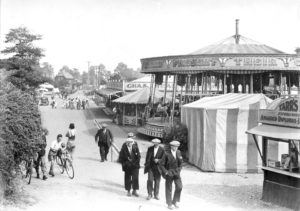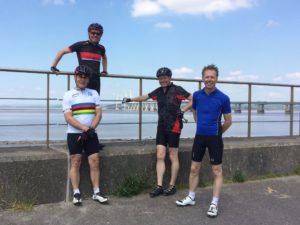by Derek Morrison

Attribution: Matt Buck [CC-BY-SA-3.0]
Click to view larger image.
Severn Beach has history
Once Blackpool of the West
Only ghostly echoes now remain
As commuters build their nest
Shirley’s Cafe near the shore
Mug of coffee from an urn
Silent juke-box in the corner
The turntable doesn’t turn
Giant slab of fruit cake
Adds to energy store
At value-for-money prices
That tempts you into more
Then visit near empty promenade
See Severn Bridges in the sky
Then listen to that whisper
Of past’s fast-fading cry.
[To listen to this verse select below]
Version 2
…….
Severn Beach has history.
Once Blackpool of the West.
Only ghostly echoes now remain,
as commuters build their nest.
Shirley’s Cafe near the shore,
draws boiling water from an urn.
Silent jukebox in the corner.
The turntable doesn’t turn.
Stop at the bakery near the steps,
where the Blue Lagoon once lay.
Now just imagine the background,
of excited populous at play.
Visit the near empty promenade.
See Severn Bridges in the sky.
Then listen to the whisper,
of the past’s fast fading cry.
[To listen to this verse select below]
Version 3
…….
Severn Beach has history.
Once Blackpool of the West.
Only ghostly echoes now remain,
as commuters build their nest.
Shirley’s Cafe near the shore,
draws boiling water from an urn.
Silent jukebox in the corner.
The turntable doesn’t turn.
Stop at the bakery near the steps,
where the Blue Lagoon once lay.
Imagine now the hubbub,
of excited populous at play.
Visit the near empty promenade.
See Severn Bridges in the sky.
Then listen to the whisper,
of the past’s fast fading cry.
[To listen to this verse select below]
Severn Beach
by
Derek Morrison
Severn Beach village was one of the micro ‘beach’ resorts that sprung up in the early 20th century to provide accessible venues for the British working class to spend their holidays or weekends. A local railway station would boost such developments. Anticipating the extension of the railway from Avonmouth docks in 1924, what had once been no more than a farm on the muddy banks of the Severn Estuary was, in 1922, transformed into a ‘seaside’ resort complete with the Blue Lagoon swimming pool, boating lake, amusements, less restrictive alcohol licensing laws than nearby Bristol – oh – and a strip club. Some wit of the past, apparently with an inclination for hyperbole, dubbed it the Blackpool of the West.
The tone of this short multimedia work attempts to convey the pathos associated with a visit to a largely forgotten landscape and history. It’s knowledge of this past which makes a visit to Severn Beach today so worthwhile. On the surface, it’s just another village on the outskirts of Bristol but, yet, walk a few yards off its main street, and you are on the banks of the Severn Estuary where the echoes of that history still reverberate. Amplify those echoes and wallow in the ambience of Shirley’s Cafe which still provides the sort of unpretentious but good food that existed before quasi bistros and gastro-pubs. If you are more a take-away person then Down’s Bakery can provide the fuel for that walk along the Severn Path.
Severn Beach, pathos, yes. But perhaps also an oasis.
Commentary
Non-UK readers may not be aware of the gentle satire intended by the musical introduction. The waves, gulls and background music would – at least for people of a certain age – evoke almost redolent memories of childhood visits to British seaside resorts of varying attractiveness. More specifically, the organ music I Do Like to be Beside the Seaside was an old British music hall song composed in 1907. The tune is now usually delivered at fast tempo as part of an organ medley and became most closely associated with the northern British resort of Blackpool where it is was routinely played in its famous Tower Ballroom; a factoid of relevance to this verse.
Severn Beach village was one of the micro ‘beach’ resorts that sprung up in the early 20th century to provide accessible venues for the British working class to spend their holidays or weekends. A local railway station would boost such developments and so, perhaps anticipating the extension of the railway from Avonmouth docks in 1924, what had once been no more than a farm on the muddy banks of the Severn Estuary was, in 1922, transformed into a ‘seaside’ resort complete with the Blue Lagoon swimming pool, boating lake, amusements (image 2), less restrictive alcohol licensing laws than nearby Bristol- oh – and a strip club. Some wit of the past, apparently with an inclination for hyperbole, dubbed it the Blackpool of the West.

Today nearly all of the artefacts of that bygone age have disappeared and Severn Beach is now a very quiet commuter village with no pub, Shirley’s Cafe, and one (rather good) bakery/micro cafe. The ‘seaside’ is actually muddy banks when the tide is out, but this area of the Severn Estuary is also a designated Site of Special Scientific Interest (SSSI) and an important haven for wildlife. I quite like the pathos it engenders when standing on its near silent promenade from which you can view the busier and noisier world in the distance, represented by the two Severn Crossings and Avonmouth, whilst imagining the sights and sounds of its more rumbustious past.
On a good weather day Severn Beach makes a worthy destination and, while I have made the trip on many occasions, my latest sojourn (25 May 2017) was as part of a small cohort from Bath Cycling Club. The photograph taken on the day shows the second Severn Crossing as the backdrop (image 3).


Further reading
Severn Beach, A Forgotten Landscape
Pilning and Severn Beach History Group